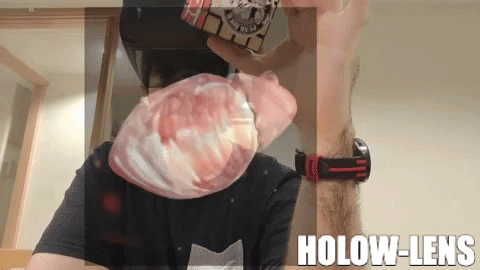Introducing HollowLens: A Budget-Friendly Hololens Alternative
Introduction
In the world of augmented reality (AR), Microsoft Hololens has been a prominent player, offering immersive experiences and cutting-edge technology. However, only some have the resources to access such advanced devices. This blog post presents HollowLens, a low-budget alternative that combines innovative DIY techniques with Unity and Vuforia to create a unique see-through AR experience. We'll delve into the creation process and demonstrate how this prototype showcases a captivating visualization of a human heart and heartbeat.
Building the Prototype
To begin, we sourced a cost-effective "fake" pass-through AR cardboard from China (cost ca. 20$), which formed the basis of our Halloween. This cardboard utilized mirrors to project the attached mobile screen content on its glass. Regardless to say mirroring a mobile screen on glass is not “real” augmented reality. However, with custom software, we could make it happen. Developing for the pass-through was straightforward; the black color cannot be mirrored; therefore, during the development, we had to disable the rendering of the live camera stream and only render the trackable augmented objects.
Using a Rubik's Cube as a Tracking Tool
To enhance interactivity through tangible interaction, we decided to leverage a Rubik's Cube as a tracking device. To make the cube trackable for Vuforias`computer vision algorithm, we added stickers to each side of the cube and created a recognizable and trackable object target. This enabled us with the basis to superimpose the 3D content (i.e., heart) over the cube, creating an engaging AR experience that could accurately track the movement of the Rubik's cube.
Visualizing the Heart and Heart Rate
With the tracking mechanism in place, our next step was to important the heart model into Unity. With additional heartbeat animation and visual FX, we were able to mimic the pulsating nature of the organ, creating a compelling visual representation. This feature highly enhanced the overall immersion and made the experience even more captivating.
Conclusion
HollowLens showcases how creativity, ingenuity, and limited resources can still yield impressive results in the realm of augmented reality. By utilizing low-cost cardboard with mirror projection, a modified Rubik's Cube as a trackable object, and the powerful Unity game engine with Vuforia, we successfully developed a budget-friendly alternative to the Hololens. The prototype effectively visualizes a human heart and heart rate, providing users with an engaging and educational AR experience.
While HollowLens may not match the sophistication and capabilities of high-end AR devices, it represents a significant step forward in democratizing augmented reality. We hope that this blog post inspires others to explore the possibilities of AR on a limited budget and encourages innovation in this rapidly evolving field.
